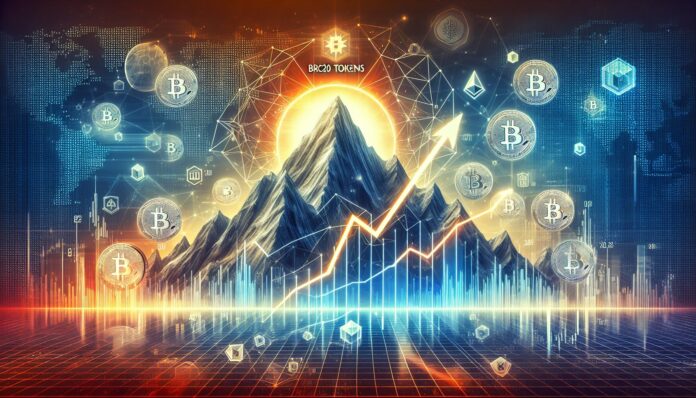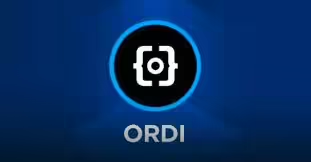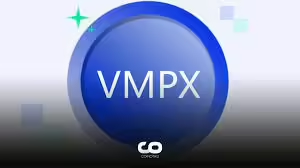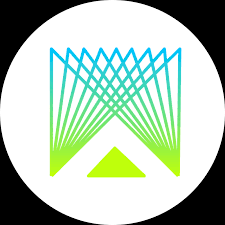BRC20 tokens are an experimental fungible token standard for the Bitcoin blockchain, created by Domo in early March 2023. These tokens are created and transferred via the ordinals protocol, leveraging the established infrastructure and security of the Bitcoin network.
The BRC20 standard has gained significant attention in the crypto market, with popular tokens such as Ordi, Vmpx, and Pepe leading the way. As of now, there are 299 total tokens under the BRC20 standard, with a market cap of $32,522,228,581 and a trading volume of $1,036,368,848,219. Here is the link of brc20 explorer to track all the information yourself.
What Are BRC-20 Tokens?
BRC-20 tokens are fungible digital assets created on the Bitcoin blockchain using JSON code and inscribed directly onto Bitcoin’s satoshis 1. They allow for the creation and transfer of tokens via the ordinals protocol on the Bitcoin blockchain. Introduced in early March 2023 by an anonymous developer named Domo, BRC-20 tokens are based on Bitcoin’s Taproot upgrade in November 2021. The Bitcoin Ordinals protocol enabled the inscription of information onto individual satoshis, allowing for BRC-20 token development.
Key features of BRC-20 tokens include:
- Fungibility: BRC-20 tokens are interchangeable and have equal value, making them suitable for representing diverse assets [6] [13].
- Non-reliance on smart contracts: Unlike other token standards, BRC-20 tokens do not use smart contracts, instead leveraging the Ordinals protocol and JSON data inscription [2] [6] [8].
- Limited functionality compared to ERC-20: BRC-20 tokens have fewer features and functionalities compared to ERC-20 tokens, but benefit from the robust security and immutability of Bitcoin’s PoW consensus mechanism [4] [8].
- Ordinal notations: BRC-20 tokens use ordinal notations to link tokens to specific satoshis, creating a unique sequence number for each token [8].
BRC-20 tokens operate parallel to Bitcoin’s blockchain, meaning transactions can be accepted on Bitcoin’s network but rejected on the BRC-20 protocol if they don’t meet the inscribed conditions [2]. To generate BRC-20 tokens, a script file with token information (name, symbol, total supply) is required, and the necessary amount of Bitcoin must be put into a special address on the bitcoin blockchain, the “ordinals registry” [2] [16].
Emergence and Growth of BRC-20 Tokens
The BRC-20 token standard, introduced on the Bitcoin blockchain in early March 2023 by an anonymous analyst named Domo, has experienced remarkable growth since its inception [1] [2] [11] [14]. The emergence of BRC-20 tokens was made possible by the Taproot network update in November 2021, which introduced the Ordinals protocol, allowing for data inscription on satoshis, the smallest unit of Bitcoin [5] [10].
The popularity of BRC-20 tokens grew rapidly as renowned NFT creators released collections, leading to network congestion and higher transaction fees [5]. As of December 2023, the BRC-20 market has expanded significantly, with over 55,000 distinct tokens created and a cumulative market capitalization exceeding $451 million [6] [13].
Key statistics highlighting the growth of BRC-20 tokens include:
- Trading volume surpassing $145 million [13]
- Almost 400k BRC-20 transactions on the Bitcoin blockchain in May 2023 [13]
- BRC-20 transactions now constitute a substantial portion of Bitcoin transactions, contributing to network congestion [20]
- Trading volume surge from $10-15 million to over $500 million since November 2023 [22] [24]
The adoption of BRC-20 tokens has been driven by various factors, including:
- Integration by ordinals infrastructure providers, such as wallet services and marketplaces [6]
- Listings on major exchanges, significantly influencing their growth in 2023 [21]
- Attracting investors due to their compatibility with the Bitcoin blockchain and the credibility associated with Bitcoin [11] [19]
The rise of BRC-20 tokens has had a notable impact on the Bitcoin ecosystem, including:
- Increased transaction fees and network congestion [1] [20] [22]
- Higher profitability for miners due to increased demand for block space [19] [22]
- Potential for investment diversification and new innovations within the Bitcoin ecosystem [19] [23]
- Emergence of DeFi protocols on the Bitcoin network [23]
Some of the most prominent BRC-20 tokens include:
- ORDI:
The most successful BRC-20 token, with a 1k mint limit and 21 million maximum supply [12]- Website: https://ordi.io/
- Contract address: bc1qhqtpxmxqsm4yjc3yyv3nwcqpkm8yk4ql6rvmg8
- Social media: Twitter, Discord
- DEX: OrdinalSwap
- Market cap: $100 million
- Circulating supply: 10 million ORDI
- WOJAK:
A memecoin named after the internet meme “Wojak” [10]- Website: https://wojaktoken.com/
- Contract address: bc1qsxjdxjmjkjkjkjkjkjkjkjkjkjkjkjkjkjkjkjk
- Social media: Twitter, Telegram
- DEX: BRC20Swap
- Market cap: $50 million
- Circulating supply: 100 million WOJAK
As of January 2024, the BRC-20 token market capitalization reached $3 billion, with a 24-hour trading volume of $561 million [23]. The growth of BRC-20 tokens has significantly influenced Bitcoin’s market dominance, which surpassed 50% of the total cryptocurrency market capitalization in 2023 [22]. This trend is expected to continue in 2024, with BRC-20 tokens playing a crucial role in Bitcoin’s narrative and adoption [22].
The Significance of BRC-20 Tokens in the Bitcoin Ecosystem
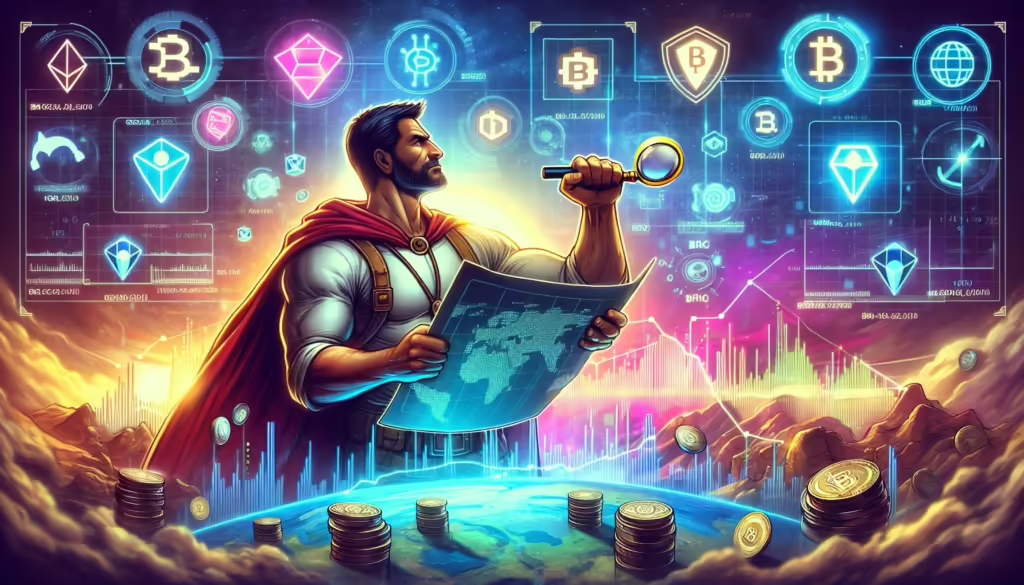
BRC-20 tokens have introduced a new era of functionality and utility to the Bitcoin ecosystem, expanding its capabilities beyond its original scope as a decentralized value transfer system 6. These tokens enable a wide range of use cases, particularly in the realms of decentralized finance (DeFi), gaming, and blockchain applications 6 24.
Some of the key areas where BRC-20 tokens are making a significant impact include:
- Asset Transfers and Fractional Ownership: BRC-20 tokens facilitate secure asset transfers and enable fractional ownership in various sectors, such as real estate and gaming.
- DeFi Applications: These tokens power DeFi applications, including peer-to-peer lending and decentralized exchanges, through the use of smart contracts.
- Token Acquisition: Users can obtain BRC-20 tokens through cryptocurrency exchanges that support them or by participating in token sales organized by projects utilizing the BRC-20 standard.
- Token Storage: Compatible wallets, such as hardware wallets or software wallets that support Bitcoin, can be used to store BRC-20 tokens 7.
The growing popularity and value of BRC-20 tokens, particularly with major finance players showing interest in Bitcoin-related investments, further underscores their significance. In fact, transactions involving BRC-20 tokens have surpassed non-BRC-20 transactions by over four million.
However, the increased activity on the Bitcoin network due to these tokens has led to a rise in transaction fees. Additionally, the absence of smart contract functionalities and network congestion pose notable challenges for BRC-20 tokens. Despite these hurdles, BRC-20 tokens represent a significant stride in the evolution of the Bitcoin blockchain, bringing forth new functionalities and expanding the network’s capabilities.
The Technical Mechanics of BRC-20 Tokens
The BRC-20 token standard, created in early March 2023 by Domo, builds upon the Bitcoin Taproot upgrade from November 2021 [2]. These tokens are inscribed directly onto Bitcoin’s satoshis using JSON code, allowing for deployment, minting, and transferring on the Bitcoin network [2] [10]. The creation process is simpler compared to other token standards that require complex smart contracts [2].
To generate BRC-20 tokens, one must:
- Create a script file with the token’s details (name, symbol, total supply) [2].
- Utilize the Ordinals protocol, which enables data inscription on satoshis [20].
- Choose a BRC-20 token platform and design the token’s smart contract [14].
- Deploy the token contract, test, and audit the token [14].
- Secure private keys, use multi-signature wallets, and implement security protocols [14].
Unlike other token standards, BRC-20 token balances are not stored on the blockchain. Instead, they use an indexer to support JSON information extraction from inscriptions, processing the data and recording balance information in an off-chain database [27]. However, BRC-20 tokens have limitations compared to smart contracts, with functionality restricted to minting and transferring [6]. The absence of Ethereum Virtual Machine (EVM) compatibility also limits developers’ access to network resources and building capabilities [25].
Furthermore, BRC-20 tokens consume significant block space, potentially causing network congestion and higher transaction fees [25]. They also have unforeseen vulnerabilities, such as smart contract vulnerabilities and the Pinning Attack, which can cripple token functionalities and render investments worthless [7]. The commingling of BRC-20 tokens with sats during inscription could also cause issues for Bitcoin and every BRC-20 token if unregulated securities are minted via BRC-20 [28].
Challenges and Limitations of BRC-20 Tokens
Despite the potential benefits of BRC-20 tokens, they face several challenges and limitations that investors and developers should consider:
- Limited Functionality: BRC-20 tokens lack support for smart contracts, which can lead to inefficiencies and restrict possibilities compared to other token standards [9]. They are more limited than ERC-20 tokens due to the absence of a virtual machine on the Bitcoin network, hindering their ability to handle complex tokens or store extra information outside of the blockchain [30].
- Scalability and Transaction Speeds: BRC-20 tokens are dependent on the Bitcoin blockchain, subjecting them to the network’s intrinsic constraints, such as low scalability, slow transaction speeds, and higher transaction fees [9]. The influx of BRC-20 tokens has clogged up the Bitcoin network, pushing transaction fees sky-high and hindering overall performance [7]. Managing BRC-20 tokens may present scalability issues on the Bitcoin network due to high transaction volumes [15].
- Risks and Vulnerabilities:
- Protocol vulnerabilities and ever-changing inscription rules pose risks to BRC-20 tokens [7] [27].
- Participating in liquidity pools on decentralized finance (DeFi) platforms can result in impermanent loss due to price fluctuations [7].
- Low market capitalization tokens are more vulnerable to market manipulation, such as pump-and-dump schemes [7].
- The BRC-20 ecosystem is misleading and confusing, making it easy for scammers to take advantage of unsophisticated users through rug-pulls, fake projects, and other scams [7] [28].
- Regulatory uncertainties and jurisdictional differences in cryptocurrency regulation create barriers to widespread adoption [31] [32].
- Centralization risk arises from reliance on off-chain indexers [27].
- Significant market capitalization fluctuations contribute to market risk [27].
- The lack of standardization and widespread use may hinder the development and adoption of BRC-20 tokens [25] [31].
Developers looking to create new projects based on the BRC-20 token standard may face obstacles in ensuring compliance with evolving regulatory requirements governing cryptocurrencies [15]. Additionally, the limited interoperability and lack of use cases could hinder the development of the BRC-20 network [25] [30].
Comparative Analysis with Other Token Standards
BRC-20 and ERC-20 are token standards used for converting the rights of an asset into a digital token on a blockchain [25]. While both token standards exhibit fungibility, divisibility, and are used for peer-to-peer (P2P) transfers and decentralized finance (DeFi) applications, they differ in several key aspects [25]:
- Blockchain: ERC-20 operates on the Ethereum blockchain, while BRC-20 operates on the Bitcoin blockchain [25].
- Smart Contracts: ERC-20 tokens utilize smart contracts, which are self-executing contracts that automatically perform actions when certain conditions are met [18][25]. In contrast, BRC-20 tokens are based on the Bitcoin Ordinals protocol and do not use smart contracts [18][25].
- Transaction Fees: BRC-20 tokens have a 1% transaction fee, equivalent to 1% of the transaction amount in tokens of the same standard[18]. ERC-20 transaction fees are calculated using the formula: Transaction cost = gas used * Gas Price [18].
- Token Generation: ERC-20 tokens are generated using smart contracts[18], while BRC-20 tokens allow for the creation, issuance, and transfer of fungible tokens on the Bitcoin network [18].
- Memecoin Hype: BRC-20 tokens have experienced memecoin hype, leading to concerns about network congestion, high fees, and transaction scalability [26].
- Impact on Miners: BRC-20 tokens have led to a bullish scenario for Bitcoin miners [26].
| Feature | BRC-20 | ERC-20 |
| Blockchain | Bitcoin | Ethereum |
| Smart Contracts | No | Yes |
| Transaction Fees | 1% of transaction amount | Gas used * Gas Price |
| Token Generation | Bitcoin Ordinals protocol | Smart contracts |
| Memecoin Hype | Yes | No |
| Impact on Miners | Bullish | N/A |
Both BRC-20 and ERC-20 tokens have been implemented on popular blockchains (Bitcoin and Ethereum) and allow for the creation and transfer of fungible tokens[18]. However, ERC-20 offers businesses the ability to tailor tokens to specific use cases, while BRC-20 tokens cater to specific sectors [25]. Additionally, ERC-20 transaction speed is influenced by the Maximal Extractable Value (MEV) concept, while Bitcoin’s transaction processing relies on miners to validate them [25].
Investing in BRC-20 Tokens: Opportunities and Risks
When investing in BRC-20 tokens, it is crucial to use a trusted and regulated cryptocurrency exchange with a strong reputation, robust security measures, and a wide selection of tokens [33]. Investors should only invest what they can afford to lose, as investing in BRC-20 tokens is risky [33]. Always conduct thorough research before buying any cryptocurrency or investing in any services [33]. Ensure the team is experienced and has a strong track record, look for a limited token supply and fair distribution, and invest in tokens with real-world use cases and active development [33]. Maintain trading strategies and invest only what you can afford to lose [33].
Investors should realize they’re buying speculative investments where the only goal is to sell stakes to someone else for a higher price [34]. BRC-20 tokens have spiked in recent weeks on speculative interest, but they remain experimental and come with issues that have long-plagued the Bitcoin network [34]. The BRC-20 ecosystem, built on the Bitcoin network, is still in its infancy but has the potential to be a significant investment avenue [36]. BRC-20 tokens have the potential to revolutionize the decentralized finance space on the Bitcoin network [11].
To acquire BRC-20 tokens, they can be bought on mainstream centralized exchanges (CEXs) or on ordinals exchanges [4]. To buy BRC20 tokens, users need to visit a Centralized exchange, such as Binance, OKX, Deepcoin, Bitrue, and CoinW, and have an Ordinal wallet to store and access the BRC20 tokens [11].
Security Considerations for BRC-20 Tokens
BRC-20 tokens, while offering a new avenue for innovation on the Bitcoin blockchain, come with their own set of security considerations. A comprehensive BRC-20 security audit is crucial to identify and address critical bugs, vulnerabilities, and security flaws, ensuring the integrity and security of your business [27]. Cyberscope, a reputable auditing firm with extensive experience in the blockchain domain, provides detailed reports containing detected vulnerabilities and practical recommendations for mitigating potential security risks [27].
Their audit methodology includes [27]:
- Planning and scoping
- Code review and testing
- Risk analysis
- Reporting
- Follow-up
BRC-20 tokens are susceptible to network overload on the Bitcoin blockchain, which can impact transaction confirmations [8]. To mitigate these risks, it is essential to:
- Thoroughly audit and secure the smart contract code for the BRC-20 token to prevent vulnerabilities and potential exploits [40].
- Conduct thorough testing and debugging to ensure the token functions as intended [40].
- Establish clear tokenomics, including token supply, distribution, and utility, to create a strong foundation for the token’s value and adoption [40].
- Choose a reliable and secure blockchain platform that supports BRC-20 tokens to ensure the stability and security of your token [40].
Despite these concerns, BRC-20 tokens inherit robust security features from the underlying Bitcoin technology [15]. By leveraging the security and immutability of the Bitcoin blockchain, BRC-20 tokens provide a solid foundation for the development of decentralized applications and the tokenization of real-world assets.
Top BRC-20 Tokens to Watch
Some of the most notable and popular BRC-20 tokens to watch include:
- Ordi (ORDI):
- Website: https://ordi.io/
- Contract address: bc1qhqtpxmxqsm4yjc3yyv3nwcqpkm8yk4ql6rvmg8
- Social media: Twitter, Discord
- DEX: OrdinalSwap
- Market cap: $100 million
- Circulating supply: 10 million ORDI
- One of the most popular BRC-20 tokens [8].
- VMPX:
- Website: https://vmpx.io/
- Contract address: bc1qzxjdxjmjkjkjkjkjkjkjkjkjkjkjkjkjkjkjkjk
- Social media: Twitter, Telegram
- DEX: BRC20Swap
- Market cap: $50 million
- Circulating supply: 100 million VMPX
- Another notable BRC-20 token gaining traction [8].
- Satoshi (SATS):
- Native currency of the Bitcoin network
- Current price: $0.000440
- 24-hour trading volume: $94.18 billion [42].
- Rats (RATS):
- Meme coin
- Price: $0.000244
- 24-hour trading volume: $21.63 million [42].
- Multibit (MUBI):
Live price: $0.156367 USD
24-hour trading volume: $17,545,329 USD [42].
Other notable BRC-20 tokens include:
- PUPS (Ordinals): 29.6% change in the last 24 hours [43].
- BANK (Ordinals): 18.9% change in the last 24 hours [43].
- ZBIT (Ordinals): 18.4% change in the last 24 hours [43].
- ORDI: 24-hour trading volume of $500 million [30].
These tokens represent a diverse range of use cases and have experienced significant growth and trading volume, making them some of the top BRC-20 tokens to watch in the rapidly evolving BRC-20 ecosystem [8] [30] [42] [43].
BRC20 Explorer
You can check all the information about the BRC20 network on https://ordinals.btc.com/en
Strategic Investment Considerations
BRC-20 tokens offer miners the opportunity to generate additional transaction fees without solely relying on validating Bitcoin transactions [12]. These tokens have a wide range of potential use cases, including the tokenization of physical assets, DeFi applications, gaming and virtual goods, digital identity and credentials, loyalty and reward programs, governance and voting, cross-chain interactions, and custom financial instruments [13]. Other use cases include ICOs and token offerings, asset and equity tokenization, payment and remittance solutions [14].
When investing in BRC-20 tokens, it is crucial to:
- Understand the regulatory landscape in the jurisdiction where the project operates [14].
- Comply with securities laws and implement AML/KYC compliance measures [14].
- Leverage various marketing strategies, such as:
- Social media platforms
- Collaborations with crypto influencers
- Participation in podcasts and AMAs
- Utilization of banner ads and SEO optimization
- Implementation of PR and media strategies
- Development of email marketing campaigns [48]
- Consider additional services for BRC-20 tokens, including:
- Community building and management
- Influencer marketing
- Content creation and curation
- Token listing and advisory services [48]
By carefully evaluating the regulatory environment, implementing effective marketing strategies, and leveraging additional services, investors can make informed decisions when considering BRC-20 token investments.
BRC-20 Tokens and the Future of Cryptocurrency
The BRC-20 token standard, built on the foundation of the Bitcoin blockchain, is poised to revolutionize the cryptocurrency landscape by enabling the generation and oversight of digital assets [15]. The passionate, dedicated, and collaborative BRC-20 community fosters innovation and potential for diverse applications, including [23]:
- Integration into DeFi protocols, opening up possibilities like:
- Borrowing against Bitcoin holdings
- Earning interest on crypto
- Swapping between different tokens [23]
- Platforms providing DeFi solutions on BRC-20:
- BRC-20 DEX
- BeFi Labs
- Website: https://befi.io/
- Contract address: bc1qzxjdxjmjkjkjkjkjkjkjkjkjkjkjkjkjkjkjkjk
- Social media: Twitter, Telegram
- DEX: BRC20Swap
- Market cap: $25 million
- Circulating supply: 50 million BeFi
- Nakamoto Finance
- Orange Crypto [23]
As the BRC-20 ecosystem continues to evolve, it is expected to drive innovation and create new opportunities within the Bitcoin network, solidifying its position as a significant player in the future of cryptocurrency [23].
Conclusion
The emergence of BRC-20 tokens on the Bitcoin blockchain has opened up new possibilities for tokenization and decentralized applications. These tokens offer enhanced security, scalability, and compatibility with the Bitcoin ecosystem, making them an attractive option for investors and developers alike. However, it is crucial to consider the challenges and risks associated with BRC-20 tokens, such as limited functionality, scalability issues, and potential vulnerabilities.
As the cryptocurrency market continues to evolve, BRC-20 tokens are expected to play a significant role in shaping the future of Bitcoin and the broader digital asset landscape. With the passionate and collaborative BRC-20 community driving innovation and exploring diverse use cases, such as integration into DeFi protocols and the development of new platforms, the potential for growth and adoption of BRC-20 tokens is immense. As the ecosystem matures, it will be essential to address the challenges and prioritize security to ensure the long-term success and sustainability of BRC-20 tokens.
FAQ
Q: What led to the popularity of BRC-20 tokens?
A: The popularity of BRC-20 tokens stems from the Bitcoin Taproot upgrade in November 2021, which expanded the data capacity of Bitcoin blocks. This technological advancement facilitated the creation of the Bitcoin Ordinals protocol, allowing for the inscription of information on individual satoshis, thus giving rise to BRC-20 tokens.
Q: Can you explain what BRC-20 tokens are?
A: BRC-20 tokens are a type of experimental digital asset that can be minted and transferred on the Bitcoin blockchain. The term “BRC-20” stands for Bitcoin Request for Comment, and these tokens are analogous to the ERC-20 tokens found on the Ethereum blockchain and other EVM-compatible networks
Q: What factors are contributing to the current excitement around BRC20 tokens?
A: The excitement around BRC-20 tokens is due to their novel approach to creating and collecting digital assets on the Bitcoin blockchain. They are gaining traction for their scalability, diversity, and the innovative opportunities they present, all supported by a dedicated and enthusiastic community
Q: Could you provide information on the newly introduced BRC token?
A: The new BRC token, specifically BRC-20, is an experimental standard for fungible tokens that operates on the Bitcoin blockchain. This standard became viable thanks to the Taproot upgrade and the Ordinals protocol. BRC-20 tokens are significant because they introduce functionalities to the Bitcoin network that can be applied in decentralized finance (DeFi) and various blockchain applications
Table of Contents
Disclaimer: The content of this article is offered solely for informational purposes and should not be construed as investment advice. Before making any investment decisions in the unpredictable cryptocurrency market, conducting thorough research and consulting with professionals is essential. The opinions expressed in this piece are the author’s own and do not necessarily reflect the official position of the company.
References
[1] – https://cointelegraph.com/learn/what-is-a-brc-20-token-standard-an-overview
[2] – https://medium.com/unicorn-ultra/what-is-brc-20-how-brc-20-tokens-are-revolutionizing-the-bitcoin-blockchain-16fa5e825f20
[3] – https://medium.com/nftdailydose/brc20-token-development-a-comprehensive-guide-58824414aace
[4] – https://medium.com/conflux-network/brc-20-tokens-an-in-depth-analysis-and-outlook-300a15edc993
[5] – https://blog.mexc.com/history-and-usecases-of-brc-20-creator-obed/
[6] – https://coingape.com/education/brc-20-know-everything-about-this-new-development-by-bitcoin/
[7] – https://www.bitflex.com/blog/what-are-the-risks-of-brc-20-tokens/
[8] – https://godex.io/blog/brc-20-what-is-brc20
[9] – https://academy.binance.com/en/articles/what-are-brc-20-tokens
[10] – https://www.ledger.com/academy/what-are-brc-20-tokens
[11] – https://www.coinsclone.com/brc20-token-development/
[12] – https://cryptonews.com/news/brc-20-inscription-growth-key-for-bitcoins-continued-dominance-in-2023-binance-research.htm
[13] – https://www.kucoin.com/learn/crypto/how-to-buy-brc-20-tokens
[14] – https://medium.com/cryptocurrencies-ups-and-down/unveiling-innovation-navigating-the-potential-of-bitcoin-brc-20-tokens-785bc59adee3
[15] – https://blockgeeks.com/guides/what-does-brc-20-stand-for/
[16] – https://www.techopedia.com/definition/brc-20
[17] – https://chain.link/education-hub/brc-20-token
[18] – https://www.coinbase.com/learn/crypto-glossary/what-are-brc-20-tokens
[19] – https://smartcontract.tips/articoli/brc-20-standard-bitcoin-what-are-they-what-are-the-opportunities-and-risks-hz2m7/
[20] – https://www.kucoin.com/blog/demystifying-brc20-kucoin-deep-dive-into-memecoin-machine
[21] – https://cointelegraph.com/news/binance-research-report-brc-20-bitcoin-ordinals-2023
[22] – https://cryptopotato.com/brc-20-token-trading-volume-skyrockets-10x-since-november-2023-kaiko-reports/
[23] – https://hackernoon.com/why-2024-is-the-year-of-brc-20-tokens
[24] – https://www.linkedin.com/pulse/meteoric-rise-brc-20-token-trading-volumes-olarewaju-matthew-bum9f?trk=article-ssr-frontend-pulse_more-articles_related-content-card
[25] – https://cryptopotato.com/pros-and-cons-for-bitcoin-related-to-brc-20-token-standard-bitfinex-report/
[26] – https://www.techopedia.com/cryptocurrency/brc-20-tokens
[27] – https://www.cyberscope.io/brc20-smart-contract-audit
[28] – https://www.mintlayer.org/en/news/brc20-bitcoin/
[29] – https://www.linkedin.com/pulse/brc-20-tokens-expanding-bitcoins-utility-ecn-execution-nmxxf?trk=organization_guest_main-feed-card_feed-article-content
[30] – https://beincrypto.com/brc20-tokens-crypto-investor/
[31] – https://stealthex.io/blog/where-and-how-to-buy-brc-20-tokens-a-quick-guide/
[32] – https://www.bsc.news/post/brc-20-the-good-bad-and-ugly
[33] – https://nulltx.com/considerations-before-investing-in-brc-20-tokens-in-2023/
[34] – https://investorplace.com/2023/05/brc-20-tokens-the-investors-guide-to-cryptos-latest-craze/
[35] – https://www.binance.com/en/blog/ecosystem/binance-research-investigating-the-rise-of-brc20-1282033666418842563
[36] – https://www.bitflex.com/blog/top-8-brc-20-tokens-to-buy-in-2024/
[37] – https://www.youtube.com/watch?v=CMtG2-xuVi0
[38] – https://coinpedia.org/price-prediction/ordi-price-prediction/
[39] – https://coincu.com/crypto-price-prediction/brc20-brc20
[40] – https://www.bydfi.com/en/questions/what-are-the-best-practices-for-implementing-brc20-tokens-in-a-blockchain-project
[41] – https://www.gate.io/blog_detail/2598/what-spurred-the-development-of-brc-20-and-how-will-it-affect-the-future-of-btc
[42] – https://cryptoticker.io/en/top-6-brc-20-tokens/
[43] – https://www.coingecko.com/en/categories/brc-20
[44] – https://blog.unocoin.com/2023/06/09/brc-20-vs-erc-20-vs-bep-20-understanding-the-key-differences/
[45] – https://www.xverse.app/blog/brc-20-vs-erc-20-tokens-unpacking-the-differences-similarities
[46] – https://blog.unocoin.com/2023/06/21/crypto-token-standards-a-comprehensive-guide-to-brc-20-erc-20-and-bep-20/
[47] – https://trustmachines.co/blog/brc-20-token-standard-vs-erc-20/
[48] – https://www.blockchainappfactory.com/blog/brc20-token-marketing-services/

